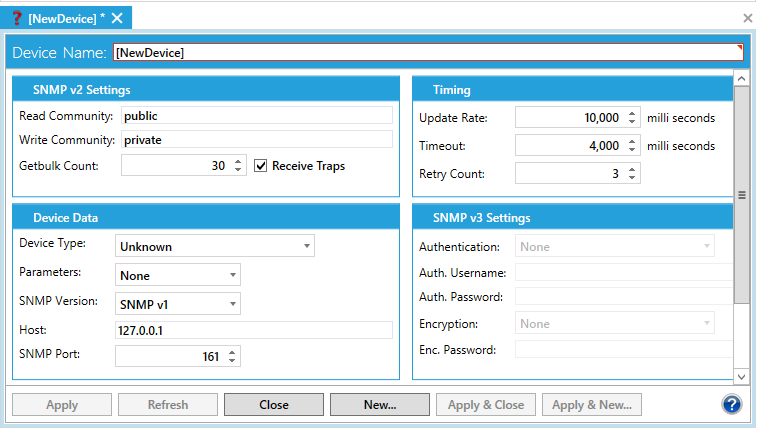
Clicking on a device (for example, a printer) shows the device properties in the right side of the Workbench.
Device Properties in the SNMP Provider in the Workbench

Device Name: Specifies the name of the device; this field has nothing to do with the DNS name.
SNMP v2 Settings
Read and Write Community: These are the passwords that enable SNMP Connector to talk with the device. If these passwords are wrong, it is impossible to read or write SNMP data on the device.
GetBulk Count: SNMP GetBulk is a new SNMP message that can request a lot of information from the device at once. With this feature, you can reduce the number of messages sent to the device and, as a consequence, the network traffic and the device's agent working time will be lower. Here you can set the maximum number of elements that can be retrieved with a single GetBulk message. Usually GetBulk is employed for arrays and tables data retrieval.
Receive Traps: Allows the machine to receive traps from the device (if the device is correctly configured).
Timing
Update Rate: This is the period (in milliseconds) between two data requests.
Timeout: Specifies the timeout of the SNMP requests to the device.
Retry Count: This value specifies how many times the SNMP Connector must try to retrieve an SNMP value.
Device Data
Device Type: The SNMP provider automatically detects the type of device, but you can modify it using additional options in the pulldown menu including: Apple, AS 400, Bridge, Firewall, Handheld, HP Printer, HUB, Linux, No SNMP, Phone, PLC, Printer, Router, Switch, Unknown, UPS, Webcam, Windows, Windows (Old Versions), and Wireless.
Parameters: Allows the creation of templates that do not have a specific IP address or port. They will be specified in GraphWorX64 (for example) as a parameter of the OID. This allows users to create aliases or pre-configured displays without changing the SNMP tags each time.
SNMP Version: Specifies either the traditional SNMP v1 (the standard version) or v2 (an update to the original version that includes additional features). The latest "v3" is not yet fully supported by SNMP Connector.
Host: Specifies the IP address of the device.
SNMP Port: You can change the default port where the SNMP service tries to connect.
SNMP v3 Settings
Authentication: SNMP v3 allows you to set an Authentication protocol. Use the pulldown menu to select from MD5, SHA or None.
Auth. Username: If you have selected an Authentication protocol, enter a User Name in this text entry field.
Auth. Password: If you have selected an Authentication protocol, enter a Password in this text entry field.
Encryption: SNMP v3 allows you to set an Encryption protocol. Use the pulldown menu to select from AES 128, AES 192, AES 256, DES, Triple DES or None.
Enc. Password: If you have selected an Encryption protocol, enter a Password in this text entry field.
NOTE: Using Federal Information Processing Standards (FIPS) with the SNMP Provider? Click HERE.
See also: